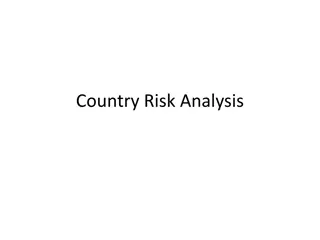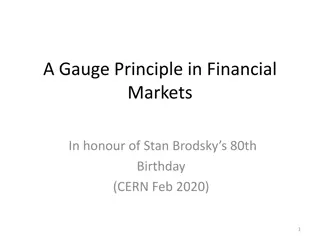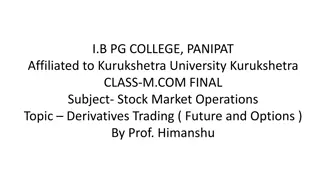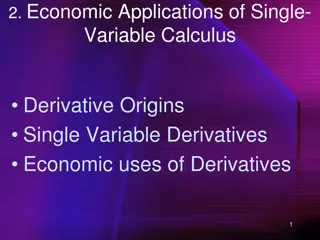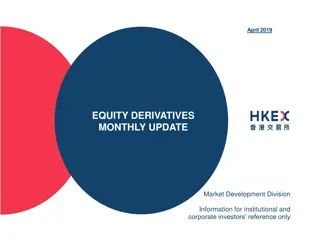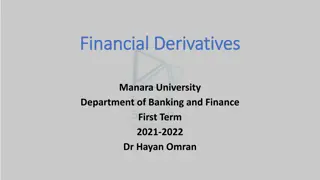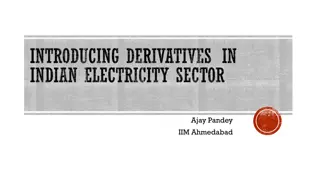Managing Risk through Derivatives: Key Developments and Strategies
Explore how to manage risk through derivatives with key developments like introducing options, establishment of repositories, and increasing position limits. Learn about the benefits of e-NWR and the key features of options compared to futures contracts. Discover the advantages of using options over futures for limited downside risk.
Download Presentation

Please find below an Image/Link to download the presentation.
The content on the website is provided AS IS for your information and personal use only. It may not be sold, licensed, or shared on other websites without obtaining consent from the author.If you encounter any issues during the download, it is possible that the publisher has removed the file from their server.
You are allowed to download the files provided on this website for personal or commercial use, subject to the condition that they are used lawfully. All files are the property of their respective owners.
The content on the website is provided AS IS for your information and personal use only. It may not be sold, licensed, or shared on other websites without obtaining consent from the author.
E N D
Presentation Transcript
Managing risk through Derivatives
Agenda Developments Group NCDEX NERL the Repository Options Soybean @ NCDEX Price Risk Risk Mitigation
Steps for market development SEBI taking over as the Regulator Reintroduction of delisted commodities Introduction of Options Establishment of Repositories Increase in position limits (In Soybean client level position limits increased from 60,000 to 1,40,000 MT) Permitting new category of participants Cat III AIFs Spot future integration 3
Not for profit institution for Education and Research NICR E-auctions, Spot markets and Unified Market Platform NCDEX Group NeML NERL A centralized repository for WDRA ReMS Karnataka State Agricultural Market Equal Joint Venture Company of NeML with Govt. of Karnataka NCCL Clearing & Settlement house
NERL - Market for warehouse receipt finance No of Active Financial Institutions (WR business) Rs. 1.66 lakh crores 75 Total Farmer Producer Companies Rs. 9 lakh crores 4,000 Rs. 35,000 crores Total No. of Primary Agriculture Co- operative societies 93,000 Total Primary Agri lending Total no. of bank branches Potential Warehouse Receipt Financing Business * Actual Warehouse Receipt Financing Business 102,343 *NABCONS 5 7
Options - Key Features SEBI has permitted European Options with commodity futures as underlying One contract per exchange would be allowed (Guar Seed for NCDEX) Underlying futures will be among the top five futures contract for the exchange. On expiration, if exercised, In the Money (ITM) Option contract to Devolve in underlying Futures Contract. long call position shall devolve into long position in the underlying futures contract long put position shall devolve into short position in the underlying futures contract short call position shall devolve into short position in the underlying futures contract short put position shall devolve into long position in the underlying futures contract Position limits of options would be separate from position limits of futures contracts. Numerical value for client level/member level position limits shall be twice of corresponding numbers applicable for futures contracts.
Options - Advantages over Futures Limited downside risk for Option Buyer. Buyer need to pay only premium hence No Mark to Market (MTM) and Margins to be paid. Higher leveraging. Commodity transaction Tax (CTT) and Transaction charges to be levied only on premium, hence lesser cost of transaction. Trading possible even without taking a price view in the market (Volatility trading). An option buyer can not only manage his risk but also capture the favorable price movement 8
Soybean @ NCDEX Oct-12 Nov-16 Merged Soybean A & B to one contract. Added Shujalpur as ADC Added Vidisha & Mandsaur as ADC. Fresh positions in last 5 days prior to expiry Jan-10 Sellers option to Compulsory delivery Feb-15 Alternate contracts in Soybean B 15-Dec-03 trading commenced Mar-16 Removed Itarsi as ADC Oct-05 Made two contracts Soybean A and B July-10 Compulsory delivery to Sellers option Oct-14 Added Latur as ADC Feb-16 Continuous contracts in Soybean B Oct-16 Made all delivery centers at par with Indore Aug-17 Launched Aug-17 contract 9
Soybean @ NCDEX Soybean Futures 450000 400000 350000 300000 250000 MT 200000 150000 100000 50000 0 03/04 04/05 05/06 06/07 07/08 08/09 09/10 10/11 11/12 12/13 13/14 14/15 15/16 16/17 ADOI 10
Soybean @ NCDEX Soybean Futures Price 4,500 4,000 3,500 Rs/Quintal 3,000 2,500 2,000 Oct Oct Oct Nov Nov Nov Dec Dec Dec Dec Mar Mar Mar May May May Apr Apr Apr Apr Jan Jan Jan Jan Feb Feb Feb Aug Aug Aug Aug Sep Sep Sep Jul Jul Jul Jul Jun Jun Jun 2014-15 2015-16 2016-17 11
Soybean @ NCDEX Handled record deposits approx. (2.5 lakh MT) of Soybean at all the nine delivery centers in last season There were no quality issues while lifting Buyers appreciated the availability and quality of Soybeans We have widened our product offering by adding three new futures contract this year Soybean Meal Rapeseed Mustard Seed Oil Cake Degummed Soy Oil 12
Price Risk Risk taking is inevitable. Managing the unwanted risk is necessary for the sustainability of the organization Price risk is the uncertainty and impact of market price fluctuations on the cash flows / profitability of an organization Complex deals, geopolitical linkages, increasing dynamism in the business environment and price volatility makes it imperative for the corporates and trading houses to look for effective and efficient tools and policies to reduce the uncertainty Price risk management is a systematic approach to understand, measure, monitor and mitigate the uncertainty of price risk and its impact on cash flows 13
Price Risk Mitigation Once the risk is identified and quantified, one can hedge the risk on a particular position by making use of Forwards contracts / Futures markets / Options Hedging mitigates the price risk but gets exposed to additional risk called basis risk Spread (basis) between Spot and Futures price keeps changing and if not addressed properly can ruin the hedge outcome To overcome the basis risk, one can alter the quantities on the Futures market for a given spot exposure, so that the expected change in the value will be equal. This is given by the Hedge variance Ratio Hedge variance ratio measure is time varying and hence improves the hedge effectiveness by constructing forward looking hedge ratio 14
Connecting Farmers to Derivatives Market Commodities traded on the Exchange platform since April 2016 Kapas 8 MT Wheat 100 MT Cocud 40 MT Castor 40 MT Turmeric 40 MT Soybean 7,790 MT Soy Meal 20 MT Barley 60 MT Maize 12,270 MT RM Cake 20 MT Guar Seed 40 MT RM Seed 360 MT Jeera 6 MT 15
Hedging Long Hedge After 2 months, in December Spot Cost = 3000 + 1.5%*2 (Interest Cost) + 30 (maintenance cost) = Rs. 3120/qtl XYZ Soybeans processing company gets an order to supply 100 MT of Soybean Meal in December. XYZ can lock in price of the raw material (Soybean) by buying 100 MT (10 lots) in Soybean December expiry contract. Spot price of Soybean in October is Rs.3000/Quintal Soybeans December futures price is 3100/Quintal On the day, Spot price rises to Rs.3100 Futures price rises to Rs.3200 Actual cost of Soybeans: Rs.3000/qtl (Saved the interest and maintenance cost) Gain in futures: 3200 - 3100 = Rs. 100/qtl Loss in Spot: 3000 - 3100 = Rs.-100/qtl 17
Hedging Short Hedge After 2 months, in June Spot Cost = 3000 + 1.5%*2 (Interest Cost) + 30 (maintenance cost) = Rs. 3120/qtl ABC company is into trading of Soybeans, gets an order to supply 100 MT of Soybeans in December and price will be decided in June. ABC can lock in price of Soybeans by selling 100 MT (10 lots) in Soybeans December expiry contract. Spot price of Soybeans in October is Rs.3000/Quintal Soybeans December futures price is 3100/Quintal On the day, Spot decreases to Rs.2900 Futures decreases to Rs.3000 Actual sales price of Soybeans: Rs.3000/qtl (Saved the interest, maintenance cost and risk of fall in price) Gain in futures: 3100 - 3000 = Rs. 100/qtl Loss in Spot: 2900 - 3000 = Rs.-100/qtl 18




